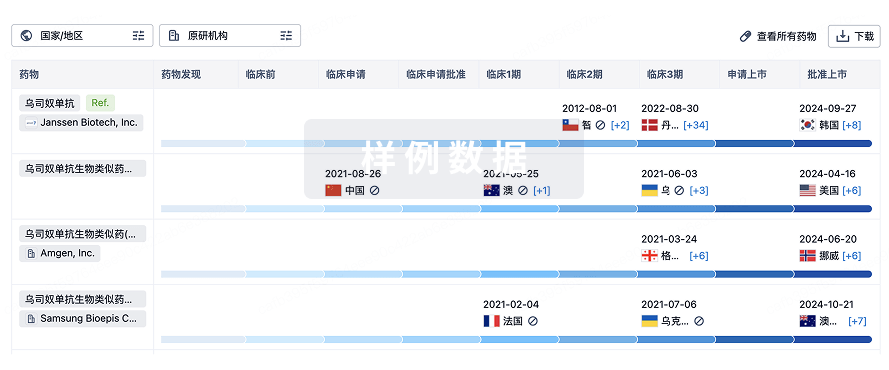预约演示
更新于:2025-12-13
Semaglutide(Hybio)
司美格鲁肽(深圳翰宇)
更新于:2025-12-13
概要
基本信息
原研机构 |
在研机构 |
非在研机构- |
最高研发阶段临床3期 |
首次获批日期- |
最高研发阶段(中国)临床3期 |
特殊审评- |
登录后查看时间轴
关联
4
项与 司美格鲁肽(深圳翰宇) 相关的临床试验CTR20243301
一项在肥胖患者中比较HY310注射液与诺和盈®治疗44周的疗效和安全性的多中心、随机、开放设计的Ⅲ期临床研究
主要目的:以原研司美格鲁肽注射液(诺和盈®)为对照,评价深圳翰宇药业股份有限公司生产的司美格鲁肽注射液(HY310注射液)辅助生活方式干预治疗肥胖患者的有效性。
次要目的:1.以原研司美格鲁肽注射液(诺和盈®)为对照,评价HY310注射液对腰围和体重指数(BMI)的影响;2.评价HY310注射液在肥胖患者中的安全性;3.评价HY310注射液在肥胖患者中的免疫原性。
开始日期2025-01-02 |
申办/合作机构 |
CTR20243084
一项在二甲双胍单药治疗血糖控制不佳的2型糖尿病患者中比较HY310注射液与诺和泰®治疗32周的疗效和安全性的多中心、随机、开放设计的Ⅲ期临床研究
主要目的:以诺和泰为对照药,评估深圳翰宇药业股份有限公司提供的司美格鲁肽注射液(HY310)在二甲双胍单药治疗血糖控制不佳的2型糖尿病患者中的有效性。
次要目的:1.以诺和泰为对照药,评估HY310注射液在二甲双胍单药治疗血糖控制不佳的2型糖尿病患者中的安全性。2.评价HY310注射液在2型糖尿病患者中的免疫原性。3.评价HY310注射液在2型糖尿病患者中的群体药代动力学特征。
开始日期2024-08-24 |
申办/合作机构 |
ACTRN12623001277639
Evaluating the efficacy of REducing cardiometabolic risk with SEmaglutide by measuring arterial stiffness in overweight and obese adults aged over 25 with Type 1 diabetes
开始日期2024-03-12 |
100 项与 司美格鲁肽(深圳翰宇) 相关的临床结果
登录后查看更多信息
100 项与 司美格鲁肽(深圳翰宇) 相关的转化医学
登录后查看更多信息
100 项与 司美格鲁肽(深圳翰宇) 相关的专利(医药)
登录后查看更多信息
3
项与 司美格鲁肽(深圳翰宇) 相关的文献(医药)2021-12-01·Cleveland Clinic journal of medicine
Antiobesity drug therapy
Letter
作者: Modarressi, Taher
To the Editor : The article by Mauer et al[1][1] in the August issue is an excellent and comprehensive review of antiobesity pharmacologic therapy. The authors twice mention the positive impact of antiobesity medications in reducing blood pressure. I wish to highlight that the pre-semaglutide trials
2019-03-01·Diabetes, obesity & metabolism2区 · 医学
Cardiovascular safety of oral semaglutide in patients with type 2 diabetes: Rationale, design and patient baseline characteristics for the PIONEER 6 trial
2区 · 医学
Article
作者: Guja, Cristian ; Bogdański, Pawel ; Jeppesen, Ole K. ; Joshi, Pankaj ; Gram, Jeppe ; Tandon, Nikhil ; Dungan, Kathleen ; Merino‐Torres, Juan F. ; Arechavaleta, Rosario ; Comlekci, Abdurrahman ; Strange, Mette ; Husain, Mansoor ; Franco, Denise R. ; Bain, Stephen C. ; Silver, Robert J. ; Faingold, Maria C. ; Tack, Cees J. ; Malek, Rachid ; Pedersen, Sue D. ; Mosenzon, Ofri ; Deerochanawong, Chaicharn ; Thomsen, Mette ; Farkouh, Michael E. ; Consoli, Agostino ; Sheu, Wayne H. ‐H. ; Nauck, Michael A.
Aims:
To assess the cardiovascular (CV) safety of oral semaglutide, the first tablet formulation of a glucagon‐like peptide‐1 receptor agonist.
Materials and methods:
PIONEER 6 is a multinational, randomized, placebo‐controlled, double‐blind trial in patients with type 2 diabetes at high risk of CV events (defined as being aged ≥50 years and having established CV disease [CVD] or moderate [stage 3] chronic kidney disease [CKD], or being aged ≥60 years with ≥1 other CV risk factor). Patients were randomized to once‐daily oral semaglutide (up to 14 mg) or placebo added to standard of care. The primary composite endpoint is time to first occurrence of CV death or non‐fatal myocardial infarction or non‐fatal stroke. The primary hypothesis was to exclude an excess in CV risk with oral semaglutide by assessing non‐inferiority versus placebo for the primary endpoint (non‐inferiority margin of 1.8 for the upper boundary of the 95% confidence interval of the hazard ratio). PIONEER 6 is event‐driven, with follow‐up continuing until accrual of at least 122 primary outcome events. There is no pre‐defined minimal duration.
Results:
Overall, 3183 patients have been enrolled (mean age 66.1 years, 31.6% females) in 214 sites across 21 countries. At baseline, the mean duration of diabetes was 14.9 years, mean glycated haemoglobin concentration was 66 mmol/mol (8.2%), and 84.6% of patients had established CVD/moderate CKD.
Conclusions:
PIONEER 6 will provide evidence regarding the CV safety of oral semaglutide in patients with type 2 diabetes and high CV risk.
2018-09-01·Diabetes, obesity & metabolism2区 · 医学
Glucagon‐like peptide‐1 receptor expression in the human eye
2区 · 医学
Article
作者: Hebsgaard, Josephine B. ; Kvist, Peter H. ; Heegaard, Steffen ; Yildirim, Emre ; Knudsen, Lotte B. ; Pyke, Charles
Semaglutide is a human glucagon‐like peptide‐1 (GLP‐1) analogue that is in development for the treatment of type 2 diabetes. In the pre‐approval cardiovascular outcomes trial SUSTAIN 6, semaglutide was associated with a significant increase in the risk of diabetic retinopathy (DR) complications vs placebo. GLP‐1 receptor (GLP‐1R) expression has previously been demonstrated in the retina in animals and humans; however, antibodies used to detect expression have been documented to be non‐specific and fail to detect the GLP‐1R using immunohistochemistry (IHC), a problem common for many G‐protein coupled receptors. Using a validated GLP‐1R antibody for IHC and in situ hybridization for
GLP‐1R
mRNA in normal human eyes, GLP‐1Rs were detected in a small fraction of neurons in the ganglion cell layer. In advanced stages of DR, GLP‐1R expression was not detected at the protein or mRNA level. Specifically, no GLP‐1R expression was found in the eyes of people with long‐standing proliferative DR (PDR). In conclusion, GLP‐1R expression is low in normal human eyes and was not detected in eyes exhibiting advanced stages of PDR.
112
项与 司美格鲁肽(深圳翰宇) 相关的新闻(医药)2025-12-12
·摩熵医药
注:本文不构成任何投资意见和建议,以官方/公司公告为准;本文仅作医疗健康相关药物介绍,非治疗方案推荐(若涉及),不代表平台立场。任何文章转载需要得到授权。
12月11日,据CDE官网显示,正大天晴子公司连云港润众制药按3.3类注册分类提交了司美格鲁肽注射液的上市申报获受理。
截图来源:CDE 官网
正大天晴的司美格鲁肽于2023年6月首次申请临床,8月获批临床,并在10 月首次启动临床。目前该药已经启动2项III期临床试验:2 型糖尿病适应症于 2024年1月启动,今年6月已完成试验;肥胖适应症则始于 2024 年 12 月,于今年8月完成患者招募。
截图来源:摩熵医药全球药物研发数据库
司美格鲁肽的核心专利将于2026 年3月到期,未来将面临着激烈的竞争。目前国内已有10款国产司美格鲁肽申报上市,分别来自正大天晴、石药集团、复星万邦、倍特药业、惠升生物、中美华东、联邦制药、九源基因、丽珠集团、齐鲁制药。
从注册分类来看,齐鲁制药和石药集团的司美格鲁肽是按照化药改良新药2.2 类申报,其它几款药都是按照生物类似药3.3类申报。
此外,还有10款国产司美格鲁肽已经进入到了临床III期阶段,来自质肽生物、华润双鹤、翰宇药业等公司。不难预料,未来国内的司美格鲁肽市场将进入残酷的竞争时代。
截图来源:摩熵医药数据库
END
本文为原创文章,转载请留言获取授权
近期热门资源获取
中国临床试验趋势与国际多中心临床展望-202505
2024年医药企业综合实力排行榜-202505
中国带状疱疹疫苗行业分析报告-202505
2023H2-2024H1中国药品分析报告-202504
数据透视:中药创新药、经典验方、改良型新药、同名同方的申报、获批、销售情况-202503
2024年中国1类新药靶点白皮书-202503
中国AI医疗健康企业创新发展百强榜单-202502
解码护肤抗衰:消费偏好洞察与市场格局分析-202502
2024年FDA批准上市的新药分析报告-202501
小分子化药白皮书(上)-202501
2024年中国医疗健康投融资全景洞察报告-202501
2024年医保谈判及市场分析报告-202501
近期更多摩熵咨询热门报告,识别下方二维码领取
联系我们,体验摩熵医药更多专业服务
会议
合作
园区
服务
数据库
咨询
定制
服务
媒体
合作
点击上方图片,即可开启摩熵化学数据查询
点击阅读原文,申请摩熵医药企业版免费试用!
临床3期生物类似药疫苗专利到期上市批准
2025-12-11
12 月 11 日,CDE 官网显示,正大天晴子公司连云港润众制药司美格鲁肽注射液申报上市,注册分类为 3.3 类。
截图来源:CDE 官网
正大天晴「司美格鲁肽」于 2023 年 6 月首次申请临床,8 月获批临床,并在 10 月首次启动临床。目前该药已经启动 2 项 III 期临床试验:
2 型糖尿病适应症于 2024 年 1 月启动,今年 6 月已完成试验;
肥胖适应症则始于 2024 年 12 月,于今年 8 月完成患者招募。
截图来源:Insight 数据库
司美格鲁肽的核心专利将于 2026 年 3 月到期,未来将面临着激烈的竞争。Insight 数据库显示,目前国内已有 10 款国产司美格鲁肽申报上市,分别来自正大天晴、石药集团、复星万邦、倍特药业、惠升生物、中美华东、联邦制药、九源基因、丽珠集团、齐鲁制药。
从注册分类来看,齐鲁制药和石药集团的司美格鲁肽是按照化药改良新药 2.2 类申报,其它几款药都是按照生物类似药 3.3 类申报。
此外,还有 10 款国产司美格鲁肽已经进入到了临床 III 期阶段,来自质肽生物、华润双鹤、翰宇药业等公司。不难预料,未来国内的司美格鲁肽市场将进入残酷的竞争时代。
Insight 数据库整理了 2025 年全球新药申报上市清单,扫描下方二维码 👇,回复关键词 新药报上市 即可免费获取(每月初更新一次,目前更新至 11 月)。
封面来源:企业logo
免责声明:本文仅作信息分享,不代表 Insight 立场和观点,也不作治疗方案推荐和介绍。如有需求,请咨询和联系正规医疗机构。
编辑:ccai
PR 稿对接:微信 insightxb
投稿:微信 insightxb;邮箱 insight@dxy.cn
2025-12-10
Medical & Beauty
内容导读
近年来,GLP-1药物无疑是全球医药市场最耀眼的明星。它以卓越的降糖减重效果,点燃了万亿级的市场想象空间,也引发了一场前所未有的“军备竞赛”。从国内药企的奋力追赶,到跨国巨头的深度布局,这条赛道已进入群雄逐鹿的白热化阶段。
今天,我们就来系统盘点一下19家在GLP-1领域崭露头角的企业。
编辑 / 减脂行业前沿 内容组
01
已获批上市,抢占市场先机
1、华东医药——利拉鲁肽注射液(商品名:利鲁平)
公司介绍:国内领先的综合性制药企业,在内分泌、自身免疫等领域深耕多年,商业化能力强大。
产品介绍:利鲁平是华东医药自主研发的利拉鲁肽生物类似药,原研为诺和诺德的诺和力®。
上市时间:2023年3月。
获批时间:2023年3月28日,获批用于成人2型糖尿病,成为国内首个获批的利拉鲁肽生物类似药。
【产品获批适应证】适用于治疗成人2型糖尿病。
2、仁会医药——贝那鲁肽注射液(商品名:菲塑美)
公司介绍:专注于创新生物药研发的中国本土企业,菲塑美是其核心产品。
产品介绍:菲塑美是全球首个且唯一的全人源GLP-1类药物,具有更高的氨基酸同源性和更低的免疫原性风险。
上市时间:2023年7月27日。
获批时间:2023年7月25日,正式获批用于肥胖或超重适应症,是国内首款获批减重适应症的GLP-1原生新药。
【产品获批适应证】适用于成年BMI≥28kg/m²(肥胖),或BMI≥24kg/m²(超重)伴至少一种体重相关合并症(如高血糖、高血压、血脂异常、非酒精性脂肪肝等)的成人患者。
3、通化东宝——利拉鲁肽注射液
公司介绍:国内胰岛素领域的传统巨头,正积极向GLP-1等新型降糖药领域拓展。
产品介绍:利拉鲁肽生物类似药,上市申请已获受理。
上市时间:2023年12月4日。
获批时间:2023年11月28日,正式获得中国国家药监局(NMPA)批准,适应症为2型糖尿病。
4、诺和诺德——司美格鲁肽注射液(商品名:诺和盈®)
公司介绍:全球糖尿病护理领域的绝对领导者,GLP-1药物的开拓者和引领者。
产品介绍:诺和盈®是原研司美格鲁肽的减重适应症商品名,其降糖版诺和泰®早已在中国上市。
上市时间:2024年11月17日上市。
获批时间:2024年6月18日,正式获得中国国家药监局(NMPA)批准,用于长期体重管理。
【产品获批适应证】用于初始BMI≥30kg/m²(肥胖),或≥27kg/m²(超重)且存在至少一种体重相关合并症(如高血糖、高血压、血脂异常、阻塞性睡眠呼吸暂停或心血管疾病等)的成人患者,作为低热量饮食和增加体力活动的辅助治疗。
5、翰宇药业——利拉鲁肽注射液
公司介绍:国内多肽药物领域的龙头企业之一,拥有“原料药+制剂”一体化优势。
产品介绍:公司自主研发的利拉鲁肽生物类似药,主要面向国际市场。
上市时间:2024年12月23日。
获批时间:2024年12月25日,获得美国FDA批准上市,成为美国首款获批的利拉鲁肽生物类似药。
6、信达生物——玛仕度肽
公司介绍:信达生物是一家集研发、生产与商业化能力于一体的综合性生物制药公司。致力于成为覆盖肿瘤、代谢性疾病、自身免疫、眼科等重大疾病领域的“全能型生物制药企业”。
产品介绍:玛仕度肽是全球首款且目前唯一获批的GCGR/GLP-1R双受体激动剂。
上市时间:2025年6月27日上市。
获批时间:2025年6月24日,正式获得中国国家药监局(NMPA)批准。
7、石药集团——司美格鲁肽注射液
公司介绍:石药控股集团有限公司是一家集创新药物研发、生产和销售为一体的国家级创新型企业。
产品介绍:此次申报的司美格鲁肽注射液由石药集团的附属公司石药集团百克(山东)生物制药股份有限公司开发,是全球首个采用全化学合成法制备的司美格鲁肽注射液。相比传统的生物发酵(DNA重组)技术,该技术路径能带来更高的原料纯度,并避免了引入外源宿主蛋白等杂质,对长期用药的安全性有潜在优势。
上市时间:2025年8月5日上市。
获批时间:2025年8月5日,正式获得中国国家药监局(NMPA)批准。
8、复星万邦(江苏)医药集团有限公司——司美格鲁肽
公司介绍:作为全国糖尿病治疗领域的领军企业,复星万邦专注于高血糖、高血压、高血脂、高尿酸及抗肿瘤等治疗领域药品的研发、生产与销售。
产品介绍:一种长效的胰高糖素样肽-1受体激动剂,通过模拟人体自身激素来降低血糖、抑制食欲。
上市时间:2025年11月7日上市。
获批时间:2025年11月7日,正式获得中国国家药监局(NMPA)批准。
9、先为达生物——伊诺格鲁肽注射液
公司介绍:先为达生物是一家处于临床阶段的全球性生物制药公司,专注于慢性代谢性疾病治疗领域创新疗法的研发。公司致力于开发具有全球知识产权和差异化优势的First-in-Class(全球首创)或Best-in-Class(同类最优)药物,以解决未被满足的临床需求。
产品介绍:伊诺格鲁肽注射液(Ecnoglutide)是先为达生物自主研发的全球首款cAMP偏向型GLP-1受体激动剂,也是公司提交IPO申请的核心资产。
与传统GLP-1药物不同,伊诺格鲁肽采用了创新的“cAMP偏向型”技术路径。它能够选择性地激活细胞内的cAMP信号通路,而减少对β-arrestin途径的激活。研究表明,过度激活β-arrestin途径可能导致GLP-1受体过多转入细胞内,从而降低药物长期疗效。伊诺格鲁肽的技术设计旨在克服这一潜在问题,从而实现更持久的治疗效果。
上市时间:2025年11月25日上市。
获批时间:2025年11月25日,正式获得中国国家药监局(NMPA)批准。
02
申报在途,蓄势待发
10、四环医药——司美格鲁肽
公司介绍:集研发、生产、销售于一体的创新型制药企业,在医美和生物药领域布局广泛。
产品介绍:司美格鲁肽生物类似药,已提交上市申请。
预计上市时间:2025年8月15日(预计)。
03
临床推进,未来可期
11、甘李药业——GZR18注射液
公司介绍:国内胰岛素类似物领域的领军企业,正在积极布局创新药管线。
产品介绍:GZR18是一款每周注射一次的GLP-1R/GCGR双靶点激动剂,正处于II/III期临床阶段。
预计上市时间:2027年下半年至2028年初(预计)。
12、华润双鹤——司美格鲁肽
公司介绍:华润集团旗下的大型化学药综合制剂企业,拥有强大的生产和渠道网络。
产品介绍:司美格鲁肽生物类似药,已获得临床试验批准。
临床受理时间:2024年9月6日。
13、君圣泰医药——HTD1801
公司介绍:君圣泰医药是一家全球一体化的生物制药公司,成立于2011年,专注于代谢性疾病和消化系统疾病领域的创新疗法开发。
产品介绍:HTD1801是君圣泰医药的核心产品,一款全球首创(First-in-Class)的新分子实体,由天然产物小檗碱(黄连素)与熊去氧胆酸(UDCA)通过离子键结合形成。作为一种口服肠肝抗炎代谢调节剂,HTD1801通过双重机制协同作用:激活AMPK通路,改善胰岛素抵抗,调节糖脂代谢;抑制NLRP3炎症小体,减轻慢性炎症,保护器官功能。
临床受理时间:2025年1月2日。
14、诺泰生物——司美格鲁肽注射液
公司介绍:国内领先的多肽药物研发与生产企业,在原料药和制剂方面均有深厚积累。
产品介绍:司美格鲁肽生物类似药,已提交临床试验申请。
预计临床受理时间:2025年底(预计)。
04
布局上游与早期研发
15、普洛药业——司美格鲁肽原料药
公司介绍:国内领先的原料药生产企业,为下游制剂厂商提供关键原料。
产品介绍:司美格鲁肽原料药,是GLP-1药物产业链的重要一环。
预计进展:本月底或下月初(预计)完成相关验证工作。
16、圣诺生物——司美格鲁肽
公司介绍:专注于多肽药物研发和生产的高新技术企业。
产品介绍:司美格鲁肽原料药及制剂。
预计进展:今年第三季度(预计)完成相关工艺验证。
17、德展健康——司美格鲁肽
公司介绍:以药品研发、生产和销售为主营业务的医药集团。
产品介绍:司美格鲁肽生物类似药。
预计上市时间:2026年(预计)。
18、康弘药业——KH110
公司介绍:国内知名的眼科和中枢神经领域创新药企。
产品介绍:KH110是一款GLP-1类药物,目前处于早期研发阶段。
19、 Metsera——MET-097i
公司介绍:一家专注于代谢性疾病治疗的国际临床阶段生物技术公司。
产品介绍:MET-097i是一款具有超长效潜力的下一代GLP-1受体激动剂,旨在实现每月一次给药。
预计上市时间:2028年至2029年(预计)。
结语
从生物类似药的快速跟进,到原生新药的差异化突破,再到多靶点、超长效的前瞻布局,中国GLP-1赛道的竞争层次已然分明。这场竞赛不仅考验着企业的研发速度与临床执行力,更对其商业化能力和供应链整合能力提出了更高要求。
未来,随着更多玩家的入局和产品的迭代,GLP-1市场的竞争将愈发激烈,而最终胜出者,必将是那些在创新、成本和生态构建上均具备核心优势的企业。这场关乎健康与财富的竞逐,好戏才刚刚开始。
「发现全球医美最前沿」
2025年度【医与美前沿】年度大会
2025第七届全球医美前沿产业大会暨了不起的先行医美人魔力星尚大赏颁奖盛典
2026年1月8日·上海
欢迎各位医美行业同仁共聚上海,共话未来
上市批准生物类似药
100 项与 司美格鲁肽(深圳翰宇) 相关的药物交易
登录后查看更多信息
外链
| KEGG | Wiki | ATC | Drug Bank |
|---|---|---|---|
| - | - | - |
研发状态
10 条进展最快的记录, 后查看更多信息
登录
| 适应症 | 最高研发状态 | 国家/地区 | 公司 | 日期 |
|---|---|---|---|---|
| 肥胖 | 临床3期 | 中国 | 2025-01-02 | |
| 2型糖尿病 | 临床3期 | 中国 | 2024-08-24 |
登录后查看更多信息
临床结果
临床结果
适应症
分期
评价
查看全部结果
| 研究 | 分期 | 人群特征 | 评价人数 | 分组 | 结果 | 评价 | 发布日期 |
|---|
No Data | |||||||
登录后查看更多信息
转化医学
使用我们的转化医学数据加速您的研究。
登录
或

药物交易
使用我们的药物交易数据加速您的研究。
登录
或

核心专利
使用我们的核心专利数据促进您的研究。
登录
或

临床分析
紧跟全球注册中心的最新临床试验。
登录
或

批准
利用最新的监管批准信息加速您的研究。
登录
或

生物类似药
生物类似药在不同国家/地区的竞争态势。请注意临床1/2期并入临床2期,临床2/3期并入临床3期
登录
或

特殊审评
只需点击几下即可了解关键药物信息。
登录
或

生物医药百科问答
全新生物医药AI Agent 覆盖科研全链路,让突破性发现快人一步
立即开始免费试用!
智慧芽新药情报库是智慧芽专为生命科学人士构建的基于AI的创新药情报平台,助您全方位提升您的研发与决策效率。
立即开始数据试用!
智慧芽新药库数据也通过智慧芽数据服务平台,以API或者数据包形式对外开放,助您更加充分利用智慧芽新药情报信息。
生物序列数据库
生物药研发创新
免费使用
化学结构数据库
小分子化药研发创新
免费使用



